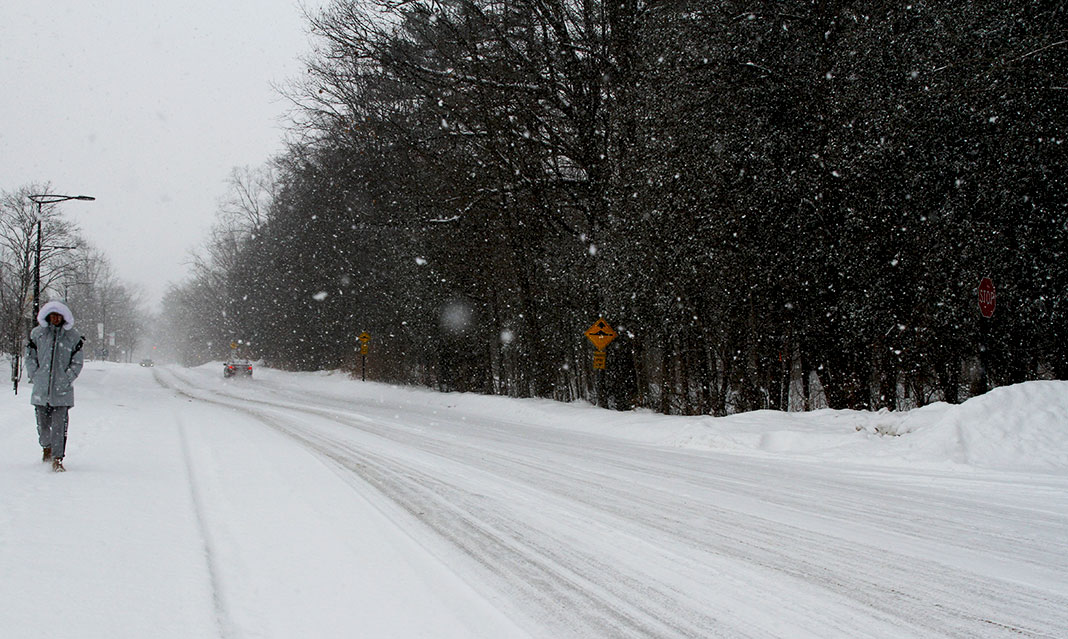In the past two weeks, the GTA has witnessed seemingly unstable weather conditions. Due to these extreme weather conditions, University of Toronto Mississauga closed the campus for two partial days and one whole day. From temperatures dropping to as low as -22ºC, rising up to 12ºC, and then dropping once again to -3ºC with a forecast of freezing rain, we are all wondering the same thing: what exactly is going on with the weather? In an interview with The Medium, Professor Kent Moore, an atmospheric physics professor in UTM’s Department of Chemical and Physical Sciences, explained the reasons behind these intense fluctuations.
In a typical winter, Ontario experiences minor fluctuations throughout the season, and these fluctuations are controlled by a certain largescale wave in the atmosphere, with a wavelength of about four thousand kilometers. This wave, unlike ocean waves that move up and down, flows from north to south and vice versa. When it flows south, it carries along air from the northern side of the globe. This air tends to be cold. The south flow results in the colder temperatures we have experienced recently. As the wave flows north, it carries with it air from the southern part of the globe, which tends to be warmer, and results in warmer weather.
While this wave is in continuous motion and these constant shifts are normal, Moore notes that recently, these fluctuations have intensified, and have become more noticeable. Although researchers have yet to know for sure the reason behind these intensifying fluctuations, many theorize that global warming is to blame. As we cause the planet to warm up, we actually affect the nature of this wave and alter its characteristics, specifically its amplitude. The altered amplitude may be causing the wave to go further south when flowing south, and go further north when flowing north. This ultimately causes the temperature to lean towards more intense extremes, which would explain the weather conditions that we have been experiencing this month.
In addition to these fluctuations, Moore mentions that we are also noticing a warming trend. In the past thirty years, Southern Ontario has warmed up by almost a full degree, so some of the warm temperatures we experience in winter are a result of this trend. That may seem like an extremely small change, but this shift carries more weight than temperatures undergoing a ten-degree shift overnight.
In previous winters, if the temperature had risen a few degrees but remained below zero, we would not have really noticed much of a difference since the snow would not have melted and we would have still needed our winter coats. Now, it has become more common for the temperature to change from negative temperatures to above zero degrees, causing the snow to melt and turn into slush.
These intense weather fluctuations are causing a collection of adverse effects on our environment. Since we went from a few days of heavy snow to warmth, the mass snow that had piled near the Don Valley area melted and resulted in floods that peaked up to 77 meters before being contained, resulting in traffic and minor infrastructure damage.
In addition, freezing rain forecasts have increased in frequency due to the upsurge in temperatures around zero. Although this situation may sound appealing to a university student since it probably means more frequent snow days, it is dangerous to both humans and animals. These freezing rain events are dangerous to drive in because roads can become extremely icy, and trees and power lines often risk falling and blocking the road or even trapping a car underneath them.
This rain, if it falls on an animal, typically freezes causing them to panic, or even end with the animal experiencing hypothermia and frostbite—two conditions that can endanger its life.
Political figures and citizens use the intensity of these cold days to debunk global warming, but what they don’t realize is that they’re missing the distinction between weather and climate. Weather is just the day to day fluctuations that we observe—few days are cold, others are warm. Those are just the natural fluctuations that happen due to a natural weather cycle. On the other hand, climate is an average over a longer period of time. The weather fluctuations are not what researchers are concerned about, but rather it is the climate trends that cause concern to arise.



